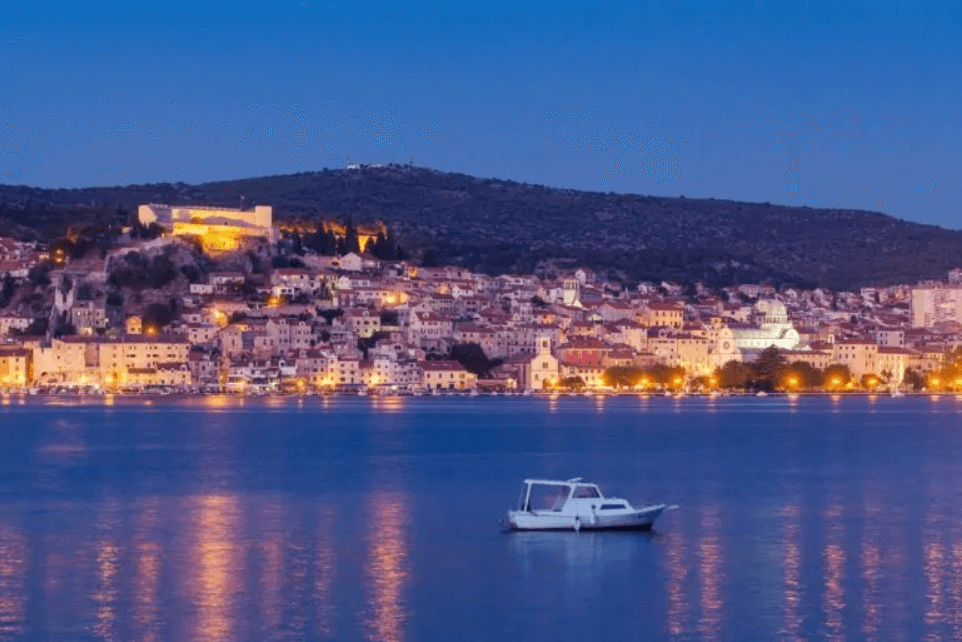3D Video Mapping to Enhance St. Michael's Fortress in Sibenik
December 19, 2019 - As part of the European project “Fortress ReInvented - An Innovative Approach and Digital Content of Historic Fortresses,” the St. Michael’s Fortress in Sibenik will be enhanced thanks to content that interprets historical heritage through digital technology.
Namely, HRTurizam writes that two underground cisterns, dating from the 15th century, have long been hidden in the interior of St. Michael’s Fortress. However, soon the legend of the city's origin and the turbulent history of the fortress will be brought back to life.
Namely, the final work is underway to set up a system for projecting 3D video mapping in the cisterns inside the fortress. From January 2020, visitors will be able to experience the history of the town of Sibenik and the fortress through two four-minute spectacles. A total of 34 projectors will be installed in the cisterns to complete the virtual space for mapping purposes, and 16 speakers will create the sound.
The first cistern will share the biblical story about the fight between good and evil, that is, the victory of St. Michael over the dragon, while the second cistern will show the history of the city with a particular emphasis on the role of the St. Michael’s Fortress as the nucleus from which the city originated.
As the latter is housed in cisterns with spatially intersected arches, they have become a watershed element in the development of a scenario-based on time travel: the cistern arches become the ‘wheels’ that start the system and define the year, that is, the period during which passengers (visitors inside the tank) stop and witness it themselves.
The complexity of implementing this project was discussed by Jelena Filipaj, a representative of Production Team, the company responsible for the development of the audio-visual content:
“Reviving cultural heritage with mapping technology is not revolutionary in itself, but so far, at least as far as we are aware, it has never been realized in such small, intimate spaces that bear the stamp of time through the colors of the walls, and from such proximity. The challenge is the curvature of the surface, which completely defines the approach to content creation. To monitor the workflow, that is, to make sure everything fits, complete simulation through virtual reality was required."
The Fortress ReInvented project covers four partner fortresses in three countries: apart from St. Michael’s Fortress, digital content will also be implemented at the Klis Fortress in Klis, Kanli Kula in Herceg Novi and Vranduk Tower in Zenica.
All the fortresses will receive multimedia guides and touch screens with a common application through which visitors to one of the fortresses will be able to watch what is currently happening at the remaining three. In addition, touch screens will be set up in the old city centers - info-kiosks through which partner fortresses will be presented, cities and small and medium-sized enterprises will be promoted.
The Fortress ReInvented project began on July 1, 2017, and ends December 31, 2019. The project is developed by the Museum of the City of Sibenik in partnership with the Municipality of Klis, the Municipality of Herceg Novi and the Public Institution Museum of the City of Zenica. Its total value is EUR 1,310,232.30, of which 85% is co-financed by the Interreg IPA CBC Croatia - Bosnia and Herzegovina - Montenegro 2014 - 2020 program.
The main objective of the project is to contribute to increasing the sustainability and improving the tourist offer by implementing digital content at four partner fortresses - St. Michael’s Fortress in Sibenik, Klis Fortress in Klis, Kanli Tower in Herceg Novi and Vranduk Fortress in Zenica.
To read more about lifestyle in Croatia, follow TCN's dedicated page.
NYE Along Croatian Coast: How Will You Ring in 2020?
December 13, 2019 - Cities along the Croatian coast set out to create the most exciting and attractive parties to ring in the New Year. While some have already announced their programs, others are waiting to surprise their citizens. A look at the NYE concert program so far.
Dalmacija Danas writes that for the fourth year in a row, New Year's Eve in Rovinj will be celebrated with an outdoor party at Marshal Tito Square, and this time, Zlatan Stipišić Gibonni will be the main star of the evening.
The New Year's tour of Istria continues in Pula, where the town’s central event will be held at the Forum with Zabranjeno pušenje and Le Monde, and, of course, midnight fireworks. Everyone who finds themselves in Portarata will be able to have fun with the performance ofŠajeta.
Maja Šuput will help ring in 2020 in Umag, while Severina will entertain Trg Slobode in Poreč.
Thousands of people flock to Rijeka every year, where, in the early hours of the new year, the audience will enjoy Dubioza Kolektiv and Nina Badrić. Opatija's New Year's Eve at the central city market will revive some of the most popular hits of the 20th century with the Opatija Tribute to the Legends and the Abba Real Tribute bands. In Mali Lošinj, the New Year's Eve party will be held at the Republic Square, where Petar Grašo will perform. The town of Rab is all ready for its December fairytale, where Tony Cetinski will take the stage.
New Year's Eve in Zadar will kick off at Petar Zoranić Square with Zaratino and TBF. Klapa Intrade and Tomislav Bralić will create a real New Year's atmosphere on the Split Riva, while Jelena Rozga will lead the crowd until the morning hours. The people of Makarska and their guests will look forward to New Year's Eve with Danijela Martinović.
New Year's Eve in Dubrovnik has been organized outdoors since 1995 on the most famous city street - Stradun. The program begins with the traditional children's party featuring Mia Dimšić, while the evening reception starts at 9 pm with Parni Valjak.
To read more about lifestyle in Croatia, follow TCN’s dedicated page.
Outlook Origins Directors Talk About Opening New Chapter in Tisno
December 13, 2019 - TCN caught up with the directors of the Outlook music festival to learn more about the first release of Outlook Origins next summer.
After a decade establishing itself as the most iconic and essential bass music event in Croatia, 2020 sees Outlook Festival open an innovative new chapter with the announcement of Outlook Origins. This all-new proposition for 2020 takes place across three special locations; The Garden Resort in Tisno for the main festival, world-famous Barbarella's for after-parties, and St Michaels Fortress for an all-new and very special opening concert.
TCN caught up with the organizers to learn more.
After a decade of Outlook Festival in Pula, you open a new chapter next summer in Tisno. What was the reasoning behind moving locations?
Outlook has been putting on Festivals in Croatia now for twelve years. Starting our journey at The Garden (Petrcane) in 2008 and eventually arriving at the gates of Fort Punta Christo in 2010. As event organisers (and music fans), we've been fortunate to hold some incredible parties with some of the biggest names in sound system culture, and do so in one of the most unique locations for events in the world. From massive opening concerts in Pula's 2000-year-old amphitheatre to the Harbour, Moat and Ballroom, our set-up at Fort Punta Christo offered people an experience unlike any other.
It's been an amazing experience for us in Pula and after ten years at the fort, we as organisers were keen to explore something new. Running such a massive event, welcoming thousands of music fans from across the globe takes a lot of work and a venue as unique as the Fort brings with it further challenges (safety, power, sound, production or beyond). We felt it was time to find a new challenge and explore other exciting routes to develop the festival and embrace sound system culture.
How will Outlook Origins be different compared with the previous editions of the Outlook Festival in Pula we know so well?
Outlook Origins explores a new model for us as a festival - one where we work closely with twelve of the scene's brightest names in sound system culture to curate our line-up. A festival line-up with some of our musical heroes working alongside - what could be better!
Exploring everything from drum and bass and dub, to reggae, roots, grime, garage and beyond, our curators will ensure the true scope of 'Outlook's' sound is represented. Alongside this, the festival becomes more intimate, offering the audience an opportunity to get up-close to the music and the artists. The Garden site is a well-loved home to many festivals, with an array of great facilities, food, drink and idyllic beach in which to enjoy outside of the music. Next summer, we'll add the Outlook touch to the site, with sound (Sinai Sound System), production, knowledge and workshops and much more still to be announced!
How will the opening concert at St. Michael’s Fortress in Sibenik compare to the Pula Arena?
This year is very much about moving forward and keeping our eyes on our plans for 2020. St. Michael's fortress is a spectacular venue with eye-dropping scenes surrounding it. It brings with it an opportunity for us as programmers to review our current model and find artists that are a perfect fit for such a space! Opening our festival the last couple of years with a massive concert (and one that has been held in a 2000-year-old amphitheatre) has been a dream - we're very excited to be able to do the same again for Outlook Origins, stay tuned for more information on the line-up early in the New Year.
What about Outlook Origins will festival-goers look forward to most next summer?
There will be lots to look forward to next year; we'll have stages of music programmed alongside our Curators bringing their favourite artists, sounds and party-starters with us to The Garden. The Outlook Boat parties will be back in full-force, as well as beach parties, after-parties and so much more. We're confident Outlook fans old and new will experience something unforgettable! There are lots more still to be revealed - keep your eyes on our channels early in the New Year!
Finally, a message to your fans in Croatia?
We are excited to be coming back to Croatia in summer next year and hope our audience are as excited about the change as we are. Outlook Origins represents something brand new for the festival, at a new location with lots of fresh ideas – we revel in our history and our time at the fort and feel extremely privileged to have found such a unique and unforgettable space to host our event over the last decade. We hope you'll join us all for the next chapter.
To read more about lifestyle in Croatia, follow TCN's dedicated page.
Touristic Valorisation of Saint Nicholas Fortress Boasts Huge Potential
As Morski writes on the 8th of December, 2019, the final conference of the project ''The touristic valorisation of Saint Nicholas Fortress in the Saint Ante Channel'' presents the results of the reconstruction of the fortress at the entrance to Šibenik.
The results of the project were presented by Prefect Goran Pauk, Director of the ''Nature'' Public Institution of Šibenik-Knin County, Anita Babačić Ajduk, Chief Designer of the Croatian Restoration Institute, Ana Škevin Mikulandra and Renata Tomljenović, research associate at the Zagreb Institute of Tourism.
''If we're using sports vocabulary, then we've reached the semifinals. We have come a long way, but the most important matches are still ahead of us. This project created all the documentation and preconditions for obtaining the funds for the complete and final reconstruction of Saint Nicholas Fortress. The next step is to include the project in the list of strategic projects of the Ministry of Culture of the Republic of Croatia,'' pointed out the Goran Pauk.
The activities and results of the Saint Nicholas Fortress project were presented by Anita Babačić Ajduk.
''First of all, thank you to the great collaborators for the project. We've obtained top quality documents that place emphasis on protection, conservation and sustainable use. This is in line with the principles of operation of our institution and the recommendations of UNESCO. Our concept and the guiding principle in the planning and implementation of projects so far and in the future is the integral sustainable management of natural and cultural heritage. These documents are not only a tool for obtaining new cash from EU funds, but also a guarantee that at the end of the process we'll receive the originally restored fortress in its full glory,'' Ajduk stated.
The main and detailed design of the fortification and renovation was presented by Ana Škevin Mikulandra, Chief Designer of the Croatian Restoration Institute:
''The project provided a solution for the rehabilitation of the dilapidated and damaged building structures of the fort. The conservation and restoration works, the construction rehabilitation and the furnishing are included. The design approach is based on conservation principles with the aim of preserving its monumental integrity and the value, with reversible contemporary interventions, all in order to contribute to the creation of new value and to position the fortress in accordance with global importance.
The Saint Nicholas Fortress' management plan was presented by a research associate of the Institute of Tourism, Renata Tomljenović:
''The plan is an instrument for the sustainable management of the fort and its contact zone. This includes protection, sustainable use, management and visitation, and funding, education and collaboration. The goal is to make the fortress world renowned for its impressive architecture in a unique natural environment, but above all to preserve its authenticity, manage it sustainably, for the benefit of citizens, visitors and future generations,'' she stated.
The project is co-financed by the European Union from the European Regional Development Fund under the Competitiveness and Cohesion Operational Program.
Make sure to follow our dedicated lifestyle page for much more.
Formula One Coming to Dalmatia? Sibenik Wants In
November 29, 2019 - Is a Formula One racetrack in Dalmatia's future? The mayor of Sibenik thinks so.
According to the statement of Zeljko Buric, the mayor of Sibenik, the Sibenik city government has not given up on their plans for an adrenaline sports zone, including a Formula 1 race track in Konjevrate. This news was shared at the 11th Mayor and Entrepreneurs meeting at the Amadria Center, reports Slobodna Dalmacija.
When presenting the city’s potential for investors, Zeljko Buric recalled that by adopting a detailed development plan, the Sibenik City Council created the preconditions for the realization of this project several years ago.
The area of about 103 hectares was also specified for the construction of a training center and a sports center for speed and adrenaline lovers, which would be a sort of counterpart to Grobnik.
“This idea, initiated by the Automotive Society of Sibenik, has not been abandoned. On the contrary, a detailed plan layout was created. Konjevrate is indeed the ideal location for such content, which would, among other things, valorize the deep hinterland of Sibenik. I find that we cannot have a strong county center if we do not have a strong hinterland, and high-octane sports are known to attract a specific clientele. There are many Formula 1 fans in Croatia and around the world, and fans of motorcycle racing and similar adrenaline sports, and among them are those with slightly deeper pockets, who personally like to follow their favorites on the track. I will also mention the possibilities that organized sports facilities of this type provide for recreational sports and its fans who would fill hotel capacities in our area outside the tourist season,” says the mayor of Sibenik.
Cedo Petrina, the current president of AMD in Sibenik, confirmed that the Automoto Society was still very interested in the realization of the project.
“Due to the fact that it is only a 10-minute drive from the center of Sibenik, and 40 kilometers from Split and Zadar, Konjevrate is an ideal position not only for arranging a certified Formula 1 track, but also for a sports-adrenaline park with all possible accompanying contents,” said Petrina.
Looking through the detailed layout of the Konjevrate training and sports center, it is evident that everything was considered - from the construction of a 3,100-meter-long track, the installation of fixed or prefabricated stands for spectators, the automotive and go-karting tracks, a racetrack, and even an open-air or drive-in cinema stage to training grounds, a heliport, children's amusement park, and skateboarding grounds. The infrastructure includes parking spaces, and accompanying facilities for catering and other objects.
Those who are more knowledgeable about the economic viability of such projects claim that similar sports centers generate respectable profits that are not circumvented by investors. If and when it happens to Sibenik, time will tell. The city government will, as promised by mayor Burić, be at their disposal for all the activities under the jurisdiction of the Sibenik city administration.
To read more about sport in Croatia, follow TCN's dedicated page.
Šibenik Through the Eyes of a Local: 5 Things Most Tourists Miss
November 23, 2019 - Šibenik is one of Dalmatia's most interesting and underrated towns. Now go a little deeper through the eyes of a local with 5 things most tourists miss.
TCN recently began an internship programme with three students from the Faculty of Political Science & Journalism at the University of Zagreb. After an excellent first article from Janja Sestak, next up please give a warm welcome to Ana Samodol who decided that she wanted to write something about her native town for her first article. I sent Ana a link to my article, Sibenik: 25 Things to Know about UNESCO's Fortress City and suggested she come up with an article on 5 things that most tourists miss that were not included in my list.
And then Ana produced THIS! I for one did not know 90% of the article below - a great start, congratulations.
(Photo credit Romulic & Stojcic)
Šibenik through the eyes of a local - so what are the things that most tourists miss once you have been to the famous cathedral and fortresses?
Šibenik has a lot of historical cultures and myths, but many famous people also come from Šibenik. I am sure that you have heard of Dražen Petrović, the legend of Croatian basketball, often called sport's Mozart. But did you know that the Phoenix Suns' basketball player, Dario Šarić is also from Šibenik? And that he and Dražen lived in the same neighborhood and played in the same sports hall.
In addition to its sports stars, Šibenk is also birthplace to some actors and directors, such as Goran Višnjić, whom you may remember from the iconic TV show ER. Director duo Ivo and Vinko Brešan, father and son, are also from Šibenik. Films such as Kako je počeo rat na mom otoku (How The War Began On My Island) and Svećenikova djeca (Priest's Children) are even filmed in the Šibenik area.
And now that we have mentioned a few famous sons, let's explore the city away from the tourist crowds.
Four Wells (Četiri bunara)
No tourist visits Šibenik without visiting its most beautiful attraction, the UNESCO World Heritage Site of the Cathedral of St. James. Now walk approximately 20 meters more and visit the Four Wells. Here's the story behind the Four Wells.
A few meters from the Cathedral of St. James you can find a plateau where people took water from wells years ago. Local people built it because of periods of drought and military siege. The construction was supervised by Juraj Dalmatinac, who is famous for building the Cathedral of St. James. After some years people forgot where they got water from in the past, so it was abandoned and forgotten. But years later townspeople who love history and architecture decided to reconstruct all four wells, renovate the floor and give it its former appearance. If you are the fan of older music, like 60s and 70s, Azimut is a great place for you to go out. And guess where is it located? Under these four wells!
During the summer there is live music outside on beautiful summer nights. Check out their Facebook page.
Walking Trail in St. Anthony's Channel (Šetnica u kanalu sv. Ante)
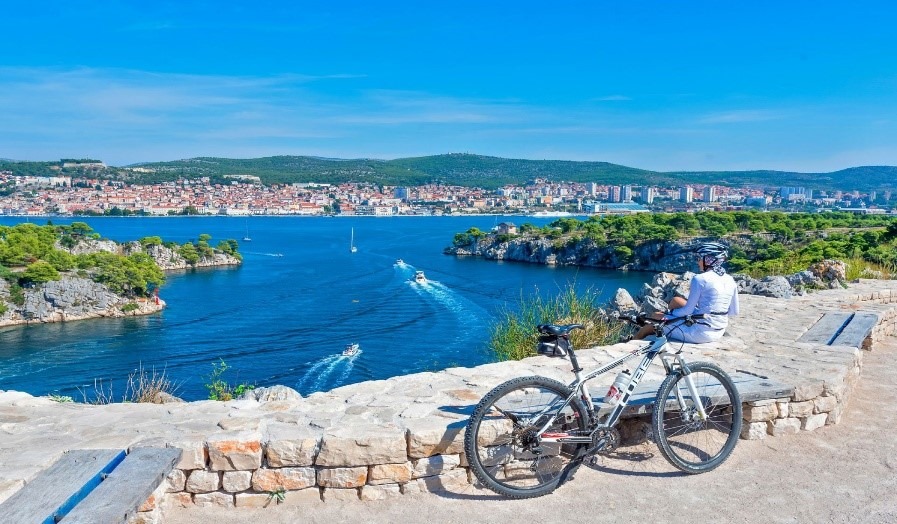
(Photo credit Sibenik Tourist Board)
The Fortress of St. Nicholas is Šibenik's second UNESCO World Heritage Site, but you can also walk and ride a bike on a walking trail in St. Anthony's Channel. In addition to cycling, you can also take family walks, jog and sightsee. On that trail there is a beautiful panoramic view to Šibenik, the Šibenik archipelago and St. Nicholas Fortress.
In that area, you can also discover Hitler's Eyes (Hitlerove oči), where you can see the beauty of the sea and take a walk in the tunnel. Hitler's Eyes is the name of a bunker which the Nazis started to construct. It was built to accommodate the Schnellboot, but was never in fact used. By the end of World War II, they had only dug the rock, which later the JNA (former Yugoslavian Army) took, reconstructed it and used it for the same purpose.
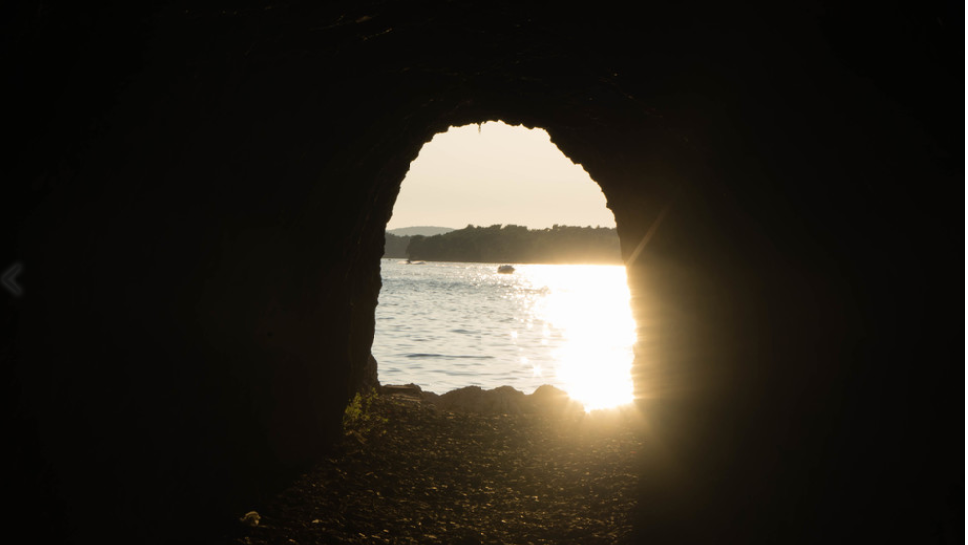
(Photo credit Sibenik Tourist Board)
While there visit the old JNA barracks, where the Kako je počeo rat na mom otoku? was shot. Anyway, walking around the area of Hitler's Eyes and walking trail, the abandoned building used to be the JNA's barracks. The windows are secured with metal railings and metal webbing. These days, the warehouses are 'decorated' with graffiti. This place is ideal for film locations, so that's why Vinko and Ivo Brešan used that location to film their famous film. It is available to you for free.
Roberto de Visiani's Park (Đardin)
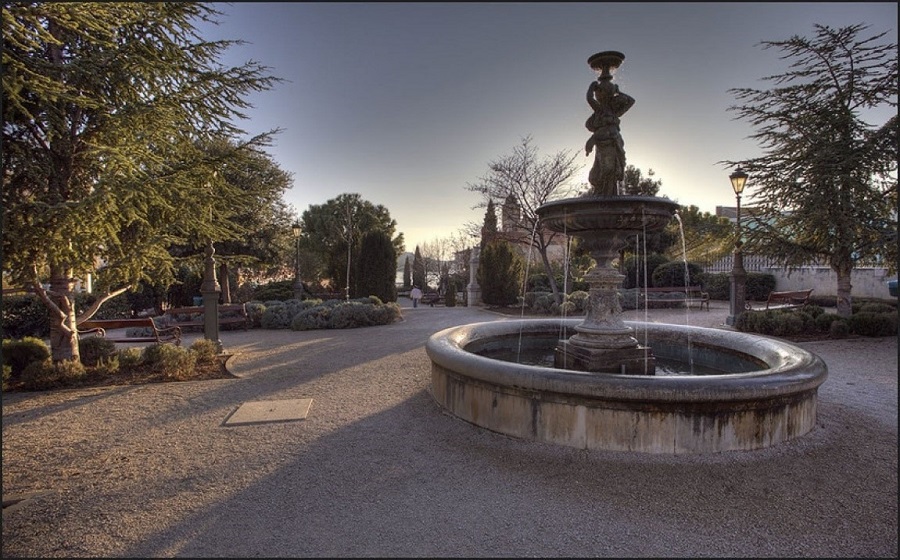
(Photo credit Sibenik Tourist Board)
Walking around the centre of town, don't miss Roberto de Visiani's Park, which locals call Đardin (from the Italian: giardino, means: garden). That park is one of the most beautiful Dalmatian parks, where culture and landscape combine. Here you can enjoy the richness and diversity of Mediterranean flora created by a man who celebrated Šibenik in the past whose name is Roberto de Visiani. He was a renowned explorer of our flora and a reformer of the oldest botanical garden in Europe, which is located in Padua. The park is located in the centre of town, between Poljana and the Šibenik waterfront. It was renovated in 1995 when the park space was mostly occupied by Mediterranean plants.
The park has three fountains and they have beautiful sculptures. During the summer it is relaxing to sit there on the benches and enjoy the summer breeze. But Đardin is also lively during the winter, especially during the Advent season. Then Đardin is decorated with Christmas decorations and also has Christmas carols. The town also organizes concerts and often has a DJ. If you want to set free your own childlike spirit or you have children of your own and you want to surprise them, nearby you have an ice rink.
St. Ana Cemetery (Groblje svete Ane)
St Michael's Fortress is one of Croatia's most spectacular buildings and even hosts concerts for the likes of Bryan Ferry, but the cemetery that is close to the fortress is often overlooked? A cemetery of myths and legends. The story takes place at the time of the Inquisition, when many believed in vampires and witches. They heard a rumour that a man who previously died wass actually a vampire, and that he woke during the night and killed the townspeople of Šibenik. Locals went crazy and they opened his grave. When they opened his grave they unleashed the plague. The man had died of the plague, and by opening that grave, they awoke the plague in Šibenik. That's the legend how the plague was brought in Šibenik.
Šibenik bridge (Šibenski most)
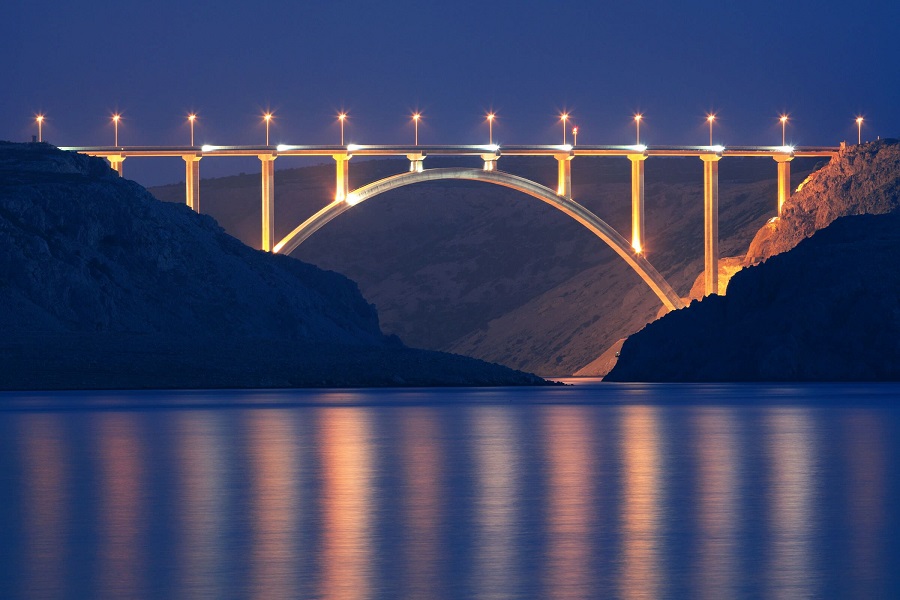
(Photo credit Romulic & Stojcic)
Šibenik bridge is one of the famous sights and destinations of Šibenik. It connects Šibenik with surrounding places such as Jadrija, Srima, Vodice, etc. The bridge is the most famous symbol of Middle Dalmatia, some 40 metres above the sea. The bridge also gives you an opportunity to do bungee jumping, if you are adventurous and brave enough. It is very safe, but you have to have a lot of nerves and courage to do it. Before you go jumping, you go through the brief instruction of jumping, where they check equipment, height and weight. This is necessary because of the length of the rope that is used for you to jump.
If you are less adventurous, there are other ways to feel the beauty of Šibenik bridge. If you are with your car, park it there and enjoy the panoramic view of Šibenik's monuments. Also on the other side you can explore the panoramic view of a small place called Zaton. On the bridge, you can take pictures and enjoy the beauty of Šibenik and the Adriatic sea. There is even a hotel where you can stay by the bridge called - yes, you guessed it - Hotel Panorama.
Take in a little more of the magic of this wonderful fortress city in the video below, and learn more in the Total Croatia Sibenik in a Page guide.
Croatia Women's Water Polo Team Qualifies for Euro 2020!
October 27, 2019 - Croatia will have two national teams at the European Water Polo Championships in Budapest next January!
Namely, Croatia’s female side won their second qualifying match against Portugal in Sibenik on Saturday and thus qualified as one of the 12 women's teams in Europe next year. The victory can be attributed to the second and third quarter of Saturday’s game, when Croatia led for the first time by 2 and 3 goals, respectively.
Portugal led from the start (0:1), though Domina Butic and Ema Carevic quickly reversed the result (2:1). Machado equalized (2:2), to which Miljkovic answered with a goal for the new lead (3:2). Portugal closed the first quarter with a goal for 3:3.
Although Croatia wasn’t particularly good at realizing their chances with a player up, Portugal was even weaker, mostly due to Croatia’s defense, headed by the goalkeeper Ratkovic.
In the second quarter with a 3:3 result, Lousa failed to realize a five-meter shot for Portugal, and from that moment, Croatia began to improve. By the end of that stretch, Domina Butic scored her second goal, and a minute before halftime, Emma Miljkovic led Croatia to a 5:3 advantage. When Ana Miroslavic scored for 6:3 before the end of the match, Croatia could already begin celebrating. Especially when Portugal's best player, Ines Braga, earned her third personal foul four minutes before the final buzzer.
For the third consecutive European Championship and fourth time ever, Croatia will have two national teams in the tournament.
The Croatia women's national team coach Mario Caleta did not hide his enthusiasm for the win.
“In Sibenik, in front of our audience, we qualified for the European Championships. We got together here for the first time two months ago, and have completed this action in the most successful way possible. First of all, we had a solid defense, which brought victory, and that's why I won't single out any players. They are all deserving. Now the girls will take a little break before reuniting in mid-December to begin preparations for the European Championships. The group is basically ideal; we have the chance for a spot in the quarterfinal, and that will be our goal.”
In addition to the match between Croatia and Portugal, other qualifying games for the European Championships in Budapest were played on Saturday night. Germany, Israel, Slovakia, France, and Serbia also qualified for the Euros next year.
Other results: Germany - Romania 14:11, Switzerland - Israel 10:16 (6:13), Turkey - Slovakia 9:16 (9:19), Serbia - Czech Republic 19: 8 (25: 6) and Ukraine - France 6:13 (1:20).
The results of the first matches are in parenthesis.
The European Championships will be held in Budapest from January 12 to 26, 2020.
Source: HVS
To read more about sport in Croatia, follow TCN’s dedicated page.
Croat Comes Up With Device for Search and Rescue Missions at Sea
Here in Croatia, he's known as a political activist, a whistleblower and as a skilled computer hacker, but that isn't all this talented Croat is about. Denis Periša, a computer genius who hails from the Dalmatian city of Šibenik is the man who built a free internet network in the city, and is also a priceless employee who works with the police in successfully searching for cyber criminals.
As Morski/Jurica Gaspar writes on the 8th of October, 2019, the ever-talented Denis Periša has come up with the idea for a device intended for search and rescue missions out at sea. This very topic was discussed back in summer, but in the meantime, it was precisely the drama around the search for another Croat lost at sea, Dino Miškić, that progressed Denis' tool that could make such situations unnecessary in the future, and save many lives with the help of cheap and very easily accessible technology.
''I'm sorry that more people aren't involved with microcontrollers and what is currently the best LoRaWAN network available in the whole of Šibenik and its surroundings. Šibenik is the first city in the region to give people that to use and develop.
To put together what we were talking about, it would be some kind of small microcontroller that, in the couple of instances where submersion [of a vessel] really ends up occurring, would activate the GPS and a beacon, and later on, a SAR ship could go out on the high seas where it's easily reachable, even if it's fifty kilometres away [from the sinking vessel]. When it comes to designing and testing this device out, I'd easily be able to install the application on all MUP vessels,'' stated Denis, with an introductory story about his idea.
''The device could be smaller. This first and largest is a microcontroller with a lot of unnecessary nonsense, so it's obviously bigger. That's the brain. You program it to work with these two sensors, for example, in certain conditions. Next to it is a LoRa communication chip, and to the right is, let's say, a gyroscope, or it can be a moisture sensor and/or a GPS system. Everything is soldered to one another, the case is printed out and that's the concept. Later, this is sent to the factory and all of it is put on one small plate,'' explained Denis.
And how does this work in the wake of a sinking ship with a crew on board?
''Well, however you can imagine. It just needs an idea. Let's say a moisture sensor and a gyroscope - to detect a sudden rolling over and the presence of water, in that way we can be sure someone is in trouble. From being in standby mode, the GPS wakes up and sends the ship's location via the LoRa system. This type of technology is very accessible nowadays. So, it could be a scenario that this set of sensors is connected to a life raft and let's say one of the sensors, specifically the one next to the red one that will, for example, measure the altitude and if that altitude goes down, to trigger an emergency beacon that will send out the vessel's GPS position.
It's clear to me that not everyone can do this, and some don't have access to it, but the fact that life rafts don't have something like this is unacceptable. This could have saved lives,'' concludes this innovative Croat, showing some miniature chips worth about fifty kuna, which could be sewn onto the seafarer's clothing, reducing potentially tragic search and rescue missions in future to the shortest possible time, thus saving lives.
Make sure to follow our dedicated Made in Croatia page for much more.
Šibenik and County are Examples of Smart Use of EU Funds
Šibenik and its surroundings within the wider Šibenik-Knin County are an area for the possible extension of the implementation of the Integrated Territorial Investment Mechanism in the financial period from 2021 to 2027.
As Lucija Spiljak/Poslovni Dnevnik writes on the 6th of October, 2019, the past weekend in Sibenik was marked by European Union funds as part of a three-day event organised by the Ministry of Regional Development and EU Funds, which presented more than 300 people in the Amadria Park tourist resort with results and good examples of using funds to change Croatia for the better.
Prime Minister Andrej Plenković opened the Days of Regional Development and EU Funds on Saturday, pointing out that when taking over the EU Funds management system, Croatia was only at nine percent of the projects contracted, and it is now, rather encouragingly, at 75 percent.
Minister for Regional Development and EU Funds, Marko Pavić, visited the EU Funds Fair, where 38 Croatian OPGs and entrepreneurs who have been fund beneficiaries presented themselves.
"We have been paid 22 billion kuna so far. EU funds improve health care and 1.7 billion kuna has been invested in hospitals and equipment, more than one billion kuna has been invested in transport infrastructure, and Pelješac bridge, worth 365 million kuna, is a permanent ''monument'' to this.
''EU funds are also changing education in Croatia, and as such, more than one billion kuna has been invested in the e-school program, and 680 million kuna in curricular reform. 6.5 million kuna has been allocated to employment, so EU funds are also contributing to young people staying in Croatia,'' Pavić said.
He is optimistic about the financial period from 2021 to 2027, when one of the goals will be, as he announced, a simpler application procedure. The City of Šibenik is one of the most positive examples of the use of EU funds and a pioneer in the restoration of cultural heritage in Croatia.
They restored the fortresses of St. Michael (Mihovil) and Barone, making Šibenik the only city in Croatia with two cultural monuments that are inscribed on UNESCO's prestigious list of protected monuments. The fortress of St. John, a project worth 41.5 million kuna, expected to be completed by the summer of 2021.
"Thanks to EU funds and cooperation with various ministries, the economy, tourism, and the education system have developed, new jobs have started to be created and it's becoming easier to attract young people, and in the future. we'll focus even more on helping young families,'' said Šibenik's mayor, Zeljko Buric.
Money from EU funds is being invested directly in the entire area of Šibenik-Knin County, stated Mayor Goran Pauk, and the projects are either implemented, are currently underway, or are being prepared.
Make sure to follow our dedicated lifestyle and politics pages for much more.
Sibenik Chocolate Bagatin Coin as New City Souvenir
September 18, 2019 - Sibenik was the first city in Croatia to mint its own money during the Venetian period. Today, the city has released a new sweet souvenir in its honor.
HRTurizam writes that back in 1485, the Venice Council of Nine approved the minting and use of Sibenik's coins - known as the bagatin, which was a means of payment in the city for more than two centuries. The bagatin was one-twelfth of a Venetian soldo, which was worth 30 Venetian ducats.
As stipulated by the Decree on Forging, on one side of the coin was the figure of St. Marcus, the patron saint of Venice, and on the other, the figure of St. Michael, patron saint of the town of Sibenik. The towns of Split, Zadar, Trogir, and Hvar began minting their bagatin shortly after.
NP Krka writes that the bagatin was saved from oblivion in 2008 by Sibenik goldsmith Ljazir Čivljak.
“He had visited the Bagatin cafe near his shop to closely examine the replica of this coin hanging on the wall in the cafe, and this inspired him to develop a version as a traditional souvenir. Civljak's bagatin is somewhat larger than the original and made of silver, unlike the original coins that were minted from copper and brass. In addition to creating this as a stand-alone souvenir, Civljak has also incorporated the coin into different jewelry pieces, such as necklaces, bracelets and rings,” reads the NP Krka website.
The Sibenik bagatin is now the city’s new sweet souvenir.
Namely, the Sibenik Bagatin Project was presented on Tuesday at the Museum of the City of Sibenik.
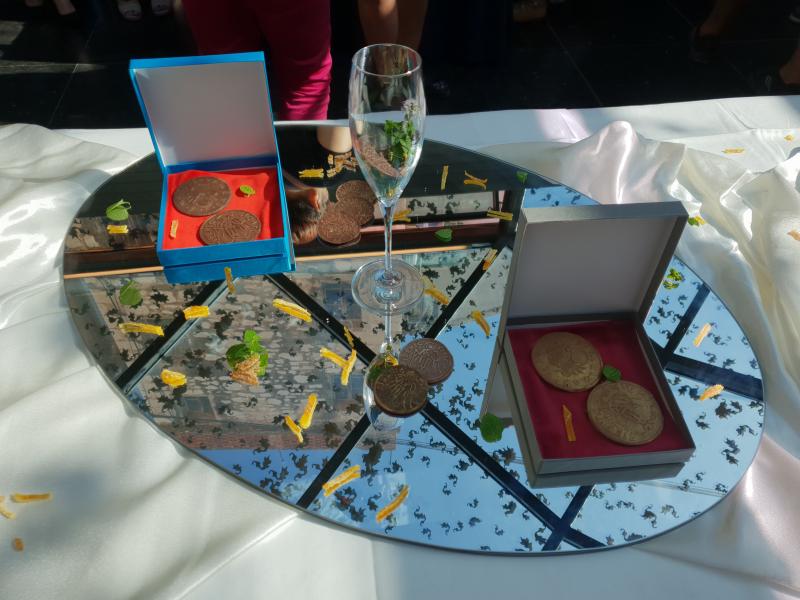
The project is a collaboration between the School of Tourism and Hospitality and the Technical School, which is funded by the Ministry of Tourism through a program to promote and strengthen the competence of vocational professions for tourism. The idea was to design the bagatin as a delicacy and as a souvenir, which was succeeded in the form of chocolate coins.
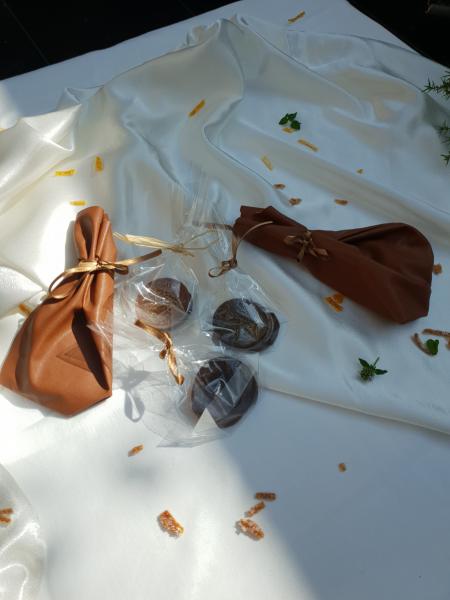
The developer of the project is the School of Tourism and Hospitality, and the Museum of the City of Sibenik plans to use this delicacy as a souvenir.
To read more about lifestyle in Croatia, follow TCN’s dedicated page.

